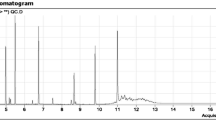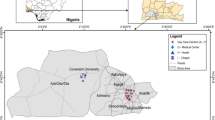Abstract
Phthalate diesters are used as plasticizers in a wide range of consumer products. Because phthalates have been shown in laboratory animal studies to be toxic, human exposure to these chemicals is a matter of concern. Nevertheless, little is known about inhalation exposure to phthalates in the United States. In this study, occurrence of nine phthalates was determined in 60 indoor air samples collected in 2014 in Albany, New York, USA. Airborne particulate and vapor phase samples were collected from various sampling locations by use of a low-volume air sampler. The median concentrations of nine phthalates in air samples collected from homes, offices, laboratories, schools, salons (hair and nail salons), and public places were 732, 143, 170, 371, 2600, and 354 ng/m3, respectively. Diethyl phthalate (DEP) was found at the highest concentrations, which ranged from 4.83 to 2250 ng/m3 (median 152) followed by di-n-butyl phthalate, which ranged from 4.05 to 1170 ng/m3 (median 63.3). The median inhalation exposure dose to phthalates was estimated at 0.845, 0.423, 0.203, 0.089, and 0.070 µg/kg-bw/d for infants, toddlers, children, teenagers, and adults, respectively. Inhalation is an important pathway of human exposure to DEP.



Similar content being viewed by others
References
Adibi J, Whyatt R, Camann D, Peki K, Jedrychowski W, Perera F (2002) Phthalate diester level in personal air samples during pregnancy in two urban pollutions. Indoor Air 4:177–182
Antian J (1973) Toxicity and health threats phthalate esters: review of the literature. Environ Health Perspect 4:1–26
Bergh C, Torgrip R, Emenius G, Ostman C (2011) Organophosphate and phthalate esters in air and settled dust—a multi-location indoor study. Indoor Air 21:67–76
Bergh C, Luongo G, Wise S, Ostman C (2012) Organophosphate and phthalate esters in standard reference material 2585 organic contaminants in house dust. Anal Bioanal Chem 402:51–59
Blanchard O, Glorennec P, Mercier F, Bonvallot N, Chevrier C, Ramalho O et al (2014) Semi-volatile organic compounds in indoor air and settled dust in 30 French dwelling. Environ Sci Technol 48:3959–3969
Boberg J, Metzdorff S, Wortziger R, Axelstad M, Brokken L, Vinggaard AM et al (2008) Impact of diisobutyl phthalate and other PPAR agonists on steroidogenesis and plasma insulin and leptin levels in fetal rats. Toxicology 250:75–81
Bornehag CG, Lundgren B, Weschler CJ, Sigsgaard T, Hagerhed-Engman L, Sundell J (2005) Phthalates in indoor dust and their association with building characteristics. Environ Health Perspect 113(10):1399–1404
Buck Louis GM, Peterson CM, Chen Z, Croughan M, Sundaram R, Stanford J et al (2013) Bisphenol A and phthalates and endometriosis: the endometriosis: natural history, diagnosis and outcomes study. Fertil Steril 100:162–169
Calafat AM, McKee RH (2006) Integrating biomonitoring exposure data into the risk assessment process: Phthalates [diethyl phthalate and di(2-ethylhexyl) phthalate] as a case study. Environ Health Perspect 114(11):1783–1789
California Environmental Protection Agency (1994) How much air do we breathe? Brief report to the scientific and technical community. Available at: http://www.arb.ca.gov/research/resnotes/notes/94-11.htm. Accessed 14 Oct 2014
Cho SC, Bhang SY, Hong YC, Shin MS, Kim BN, Kim JW et al (2010) Relationship between environmental phthalate exposure and the intelligence of school-age children. Environ Health Perspect 118:1027–1032
Clark KE, David RM, Guinn R, Kramarz KW, Lampi MA, Staples CA (2011) Modeling human exposure to phthalate esters: a comparison of indirect and biomonitoring estimation methods. Human Ecol. Risk Assess 17:923–965
Clausen PA, Liu Z, Xu Y, Korfoed-Sørensen V, Little JC (2010) Influence of air flow rate on emission of DEHP from vinyl flooring in the emission cell FLEC: measurements and CFD simulation. Atmos Environ 44:2760–2766
Clausen PA, Liu Z, Kofoed-Søorensen V, Little J, Wolkoff P (2012) Influence of temperature on the emission of di-(2-ethylhexyl) phthalate (DEHP) from PVC flooring in the emission cell PLEC. Environ Sci Technol 46:909–915
Cousins AP, Holmgren T, Remberger M (2014) Emissions of two phthalate esters and BDE-209 to indoor air and their impact on urban air quality. Sci Total Environ 470–471:527–535
Engel SM, Miodovnik A, Canfield RL, Zhu C, Silva MJ, Calafat AM et al (2010) Prenatal phthalate exposure is associate with childhood behavior and executive functioning. Environ Health Perspect 118:565–571
Finizio A, Mackay A, Bidleman T, Harner T (1997) Octanol-air partition coefficient as a predictor of partitioning of semi-volatile organic chemicals to aerosols. Atmos Environ 31:2289–2296
Fromme H, Lahrz T, Piloty M, Gebhart H, Oddoy A, Ruden H (2004) Occurrence of phthalate and musk fragrances in indoor air and dust from apartments and kindergartens in Berlin (Germany). Indoor Air 14:188–195
Fromme H, Lahrz T, Hainsch A, Oddoy A, Piloty M, Rüden H (2005) Elemental carbon and respirable particulate matter in the indoor air of apartments and nursery schools and ambient air in Berlin (Germany). Indoor Air 15:335–341
Gaspar FW, Castorina R, Maddalena RL, Nishioka MG, McKone TE, Bradman A (2014) Phthalate exposure and risk assessment in California child care. Environ Sci Technol 48:7593–7601
Gray LE, Laskey J, Ostby J (2006) Chronic di-n-butyl phthalate exposure in rats reduces fertility and alters ovarian function during pregnancy in female long Evans hooded rats. Toxicol Sci 93(1):189–195
Guo Y, Kannan K (2011) Comparative assessment of human exposure to phthalate esters from house dust in China and the United States. Environ Sci Technol 45:3788–3794
Guo Y, Kannan K (2012) Challenges encountered in the analysis of phthalate esters in foodstuffs and other biological matrices. Anal Bioanal Chem 404(9):2539–2554
Guo Y, Kannan K (2013) A survey of phthalates and parabens in personal care products from the United States and its implications for human exposure. Environ Sci Technol 47:14442–14449
Guo Y, Alomirah H, Cho HS, Minh TB, Mohd MA, Nakata H et al (2011a) Occurrence of phthalate metabolites in human urine from several Asian countries. Environ Sci Technol 45:3138–3144
Guo Y, Wu Q, Kannan K (2011b) Phthalate metabolites in urine from China, and implications for human exposures. Environ Int 37:893–898
Guo Y, Zhang Z, Liu L, Li Y, Ren N, Kannan K (2012) Occurrence and profiles of phthalates in foodstuffs from China and their implications for human exposure. J Agric Food Chem 60:6913–6919
Guo Y, Wang L, Kannan K (2014) Phthalates and parabens in personal care products from China: concentrations and human exposure. Arch Environ Contam Toxicol 66:113–119
Hauser R, Calafat AM (2005) Phthalates and human health. Occup Environ Med 62:806–818
Hubinger JC, Havery DC (2006) Analysis of consumer cosmetic products for phthalate esters. J Cosmet Sci 57:127–137
Kanazawa A, Saito I, Araki A, Takeda M, Ma M, Saijo Y et al (2010) Association between indoor exposure to semi-volatile organic compounds and building-related symptoms among the occupants of residential dwellings. Indoor Air 20:72–84
Kawamura Y, Nakajima A, Mutsuga M, Yamada T, Maitani T (2001) Residual chemical in silicone rubber products for food contact use. Shokuhin Eiseigaku Zasshi 2:316–321
Koniecki D, Wang R, Moody RP, Zhu J (2011) Phthalates in cosmetic and personal care products: concentrations and possible dermal exposure. Environ Res 111:329–336
Koo HJ, Lee BM (2005) Human monitoring of phthalates and risk assessment. J Toxicol Environ Health A 68(16):1379–1392
Kubwabo C, Rasmussen PE, Fan X, Kosarac I, Wu F, Zidek A et al (2013) Analysis of selected phthalates in Canadian indoor dust collected using household vacuum and standardized sampling techniques. Indoor Air 23:506–514
Liang Y, Xu Y (2014) Emission of phthalates and phthalate alternatives from vinyl flooring and crib mattress covers: the influence of temperature. Environ Sci Technol 48:14228–14237
Liang Y, Xu Y (2015) The influence of surface sorption and air flow rate on phthalate emissions from vinyl flooring: measurement and modeling. Atmos Environ 103:147–155
Lin S, Ku HY, Su PH, Chen JW, Huang PC, Angerer J et al (2011) Phthalate exposure in pregnant women and their children in central Taiwan. Chemosphere 82:947–955
Pei XQ, Song M, Guo M, Mo FF, Shen XY (2013) Concentration and risk assessment of phthalates present in indoor air from newly decorated apartments. Atmos Environ 68:17–23
Rudel RA, Perovich LJ (2009) Endocrine disrupting chemicals in indoor and outdoor air. Atmos Environ 43:170–181
Rudel RA, Camann DE, Spengler JD, Korn LR, Brody JG (2003) Phthalates, alkylphenols, pesticides, polybrominated diphenyl ethers, and other endocrine-disrupting compounds in indoor air and dust. Environ Sci Technol 37(20):4543–4553
Schecter A, Lorber M, Guo Y, Wu Q, Yun SH, Kannan K et al (2013) Phthalate concentrations and dietary exposure from food purchased in New York state. Environ Health Perspect 121:473–479
Schossler P, Schripp T, Salthammer T, Bahadir M (2011) Beyond phthalates: Gas phase concentration and modeled gas/particle distribution of modern plasticizers. Sci Total Environ 409:4031–4038
Turpin BJ, Lim HJ (2001) Species contributions to PM2.5 mass concentrations: revisiting common assumptions for estimating organic mass. Aerosol Sci Technol 35:602–610
United States Environmental Protection Agency (2008) Child-specific exposure factors handbook (final report). Available at: http://cfpub.epa.gov/ncea/cfm/recordisplay.cfm?deid=199243
United States Environmental Protection Agency (2012a) Butyl benzyl phthalate (CASRN 85-68-7). Available at: http://www.epa.gov/iris/subst/0293.htm. Accessed 26 Nov 2012
United States Environmental Protection Agency (2012b) Dibutyl phthalate (CASRN 84-74-2). Available at: http://www.epa.gov/iris/subst/0038.htm. Accessed 15 Mar 2012
United States Environmental Protection Agency (2012c) Di(2-ethylhexyl)phthalate (DEHP) (CARSN 117-81-7). Available at: http://www.epa.gov/iris/subst/0014.htm. Accessed 15 Mar 2012
United States Environmental Protection Agency (2012d) Diethyl phthalate (CASRN 84-66-2). Available at: http://www.epa.gov/iris/subst/0226.htm Accessed 15 Mar 2012
Weschler CJ, Nazaroff WW (2010) SVOC partitioning between the gas phase and settled dust indoors. Atmos Environ 44:3609–3620
Weschler CJ, Salthammer T, Fromme H (2008) Partitioning of phthalates among the gas phase, airborne particles and settled dust in indoor environments. Atmos Environ 42:1449–1460
Author information
Authors and Affiliations
Corresponding author
Electronic supplementary material
Below is the link to the electronic supplementary material.
Rights and permissions
About this article
Cite this article
Tran, T.M., Kannan, K. Occurrence of Phthalate Diesters in Particulate and Vapor Phases in Indoor Air and Implications for Human Exposure in Albany, New York, USA. Arch Environ Contam Toxicol 68, 489–499 (2015). https://doi.org/10.1007/s00244-015-0140-0
Received:
Accepted:
Published:
Issue Date:
DOI: https://doi.org/10.1007/s00244-015-0140-0




